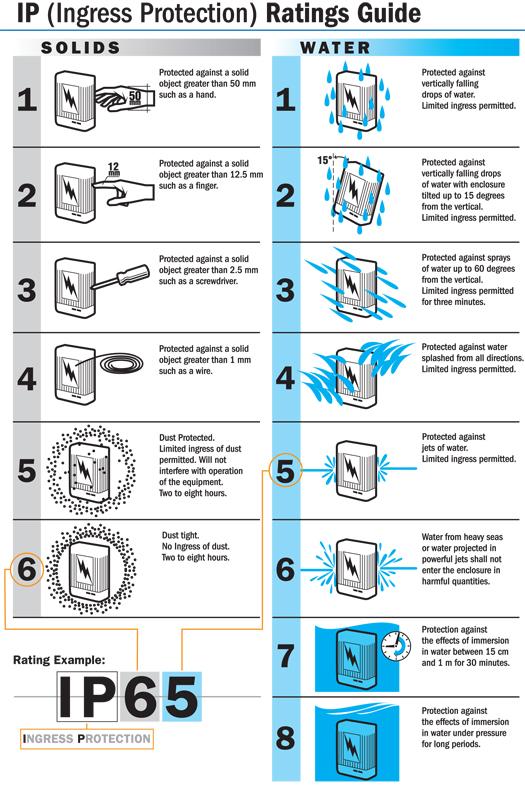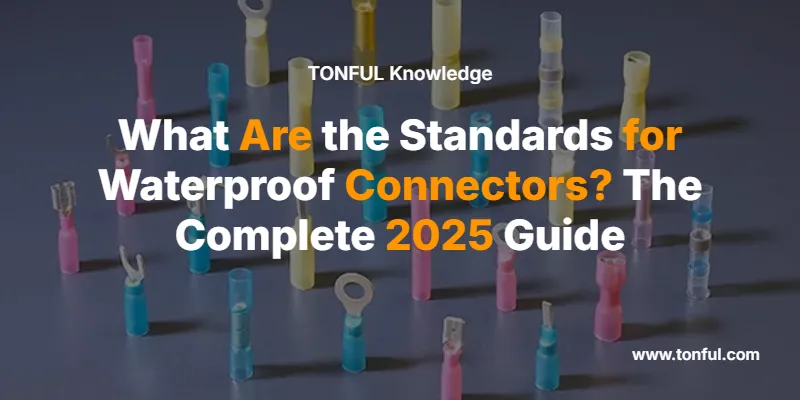Understanding waterproof connector standards is crucial for ensuring reliable electrical connections in challenging environments. Whether you’re designing industrial equipment, automotive systems, or marine applications, selecting connectors with the right protection standards prevents costly failures and safety hazards.
Key Waterproof Connector Standards Overview
The three primary rating systems for waterproof connectors are:
- IP Ratings (International) – Global standard for ingress protection
- NEMA Ratings (North America) – US-focused environmental protection
- Military Standards (MIL-DTL) – Defense and aerospace applications
IP Ratings: The Global Standard for Waterproof Connectors
What is an IP Rating?

IP rating codes are internationally recognized and follow a standardized scale defined in IEC 60529 and its national or regional equivalents such as ANSI 60529 in the US and EN 60529 in Europe. The code contains the IP prefix followed by two numbers describing protection levels.
IP Rating Structure:
- First digit (0-6): Protection against solid objects and dust
- Second digit (0-9): Protection against liquid ingress
- Optional letters: Additional specifications (like “K” for high-pressure applications)
Complete IP Rating Breakdown
| IP Rating | Solid Protection | Liquid Protection | Typical Applications |
|---|---|---|---|
| IP65 | Dust-tight | Water jets from all directions | Outdoor utility cabinets, industrial enclosures |
| IP67 | Dust-tight | Immersion up to 1 meter for 30 minutes | Marine electronics, outdoor sensors |
| IP68 | Dust-tight | Continuous submersion deeper than 1 meter | Underwater equipment, pond pumps |
| IP69K | Dust-tight | High-pressure, high-temperature jets (1450 PSI at 176°F) | Food processing, automotive wash-down |
🔧 Expert Tip: Connectors with individual IP ratings do not automatically create an IP rated connection when mated – additional sealing mechanisms are required for the interface between plug and receptacle.
IP67 vs IP68: Which Do You Need?
Choose IP67 when:
- Temporary water exposure is expected
- Cost is a primary concern
- Equipment won’t be permanently submerged
Choose IP68 when:
- Continuous underwater operation required
- Depth exceeds 1 meter
- Long-term reliability is critical
NEMA Ratings: North American Standard
Understanding NEMA vs IP Ratings
NEMA ratings include supplementary protection standards against corrosion resistance and atmospheric gases while IP ratings cover protection only against the ingress of water and solid objects.
NEMA to IP Rating Comparison
| NEMA Rating | IP Equivalent | Protection Level | Applications |
|---|---|---|---|
| NEMA 4 | IP65/IP66 | Hose-directed water, dust | General outdoor use |
| NEMA 4X | IP66 | Dust, hose-directed water, corrosion resistance | Corrosive environments |
| NEMA 6P | IP67/IP68 | Prolonged submersion | Underground installations |
⚠️ Safety Warning: There is no direct conversion between NEMA and IP ratings. NEMA standards meet or exceed IP ratings, but IP ratings do not necessarily meet NEMA standards.
Military Standards (MIL-DTL) for Harsh Environments
Primary Military Connector Standards
MIL-DTL-38999 – High-density, environmentally resistant circular connectors with operating range -65°C to +200°C
- Bayonet, threaded, or breech-lock coupling
- Up to 156 contacts
- Modern military and aerospace equipment
MIL-DTL-5015 – Medium-density connectors with threaded coupling, operating range -55°C to +125°C
- Up to 128 contacts
- Legacy military systems
- Industrial heavy-duty applications
MIL-DTL-26482 – Quick-disconnect circular connectors with bayonet coupling, operating temperature -55°C to 125°C
Military vs Commercial Comparison
| Feature | Military (MIL-DTL) | Commercial (IP/NEMA) |
|---|---|---|
| Temperature Range | -65°C to +200°C | -40°C to +125°C |
| Contact Density | Up to 156 contacts | Varies by design |
| Environmental Testing | Salt spray, vibration, shock | Basic ingress protection |
| Cost | Higher | Lower |
IP69K: The Ultimate Protection Standard
What Makes IP69K Special?
The IP69K rating provides protection against ingress of dust and high temperature, high pressure water, making products with this certification ideal for conditions where equipment must be carefully sanitized.
IP69K Test Requirements
Test Conditions:
- Water pressure: 1,160-1,450 PSI
- Water temperature: 176°F (80°C)
- Flow rate: 4 gallons per minute
- Distance: 4-6 inches from nozzle
- Rotation: Turntable rotating 5 RPM
Industries Requiring IP69K:
- Food processing and packaging
- Pharmaceutical manufacturing
- Commercial vehicle wash systems
- Heavy equipment requiring steam cleaning
Connector Selection Guide: Choosing the Right Standard
Step-by-Step Selection Process
- Identify Your Environment
- Indoor vs outdoor installation
- Presence of dust, debris, chemicals
- Water exposure type and duration
- Determine Regional Requirements
- North America: Consider NEMA ratings
- International: Use IP ratings
- Military/Aerospace: Specify MIL-DTL standards
- Assess Performance Requirements
- Operating temperature range
- Electrical specifications
- Mechanical durability needs
Quick Reference Decision Matrix
| Environment Type | Recommended Standard | Minimum Rating |
|---|---|---|
| General Outdoor | IP Rating | IP65 |
| Marine/Underwater | IP Rating | IP67/IP68 |
| Food Processing | IP Rating | IP69K |
| US Industrial | NEMA Rating | NEMA 4X |
| Military/Aerospace | MIL-DTL | MIL-DTL-38999 |
💡 Expert Recommendation: For harsh environments, electrical connectors should always be dust-tight with appropriate water ingress protection, implying a protection level of IP68 or higher.
Safety and Compliance Considerations
Critical Safety Requirements
⚠️ Important: Always verify that your waterproof connector meets local electrical codes and installation standards. Key considerations include:
- Certification Requirements: Look for UL, CE, or other relevant safety certifications
- Installation Standards: Follow manufacturer guidelines for proper sealing
- Maintenance Protocols: Regular inspection of seals and gaskets
- Environmental Compatibility: Ensure materials resist specific chemicals or conditions
Common Installation Mistakes to Avoid
- Inadequate Sealing: Implementing custom-shaped gaskets or O-rings is essential for effective sealing
- Incorrect Rating Selection: Using IP67 where IP68 is required for permanent submersion
- Neglecting Temperature Limits: Exceeding specified operating temperature ranges
- Poor Cable Management: Compromising IP rating through improper cable entry
Frequently Asked Questions
What’s the difference between waterproof and water-resistant connectors?
There’s a difference between water-resistant and waterproof – splashproof doesn’t mean immersible. Waterproof connectors (IP67/IP68) can handle submersion, while water-resistant connectors (IP65/IP66) only protect against sprays and jets.
Can I use an IP67 connector underwater permanently?
No. IP67 connectors can be submerged up to 1 meter for 30 minutes, while IP68 connectors can be immersed deeper than 1 meter for extended durations. For permanent underwater use, choose IP68 with manufacturer-specified depth ratings.
Do mated waterproof connectors maintain their IP rating?
It is important to clarify that plugs and connectors with individual IP ratings do not automatically create an IP rated connection unless a design integrates an additional sealing mechanism. Look for connectors specifically designed for mated waterproof operation.
What’s the highest IP rating available?
IP69K connectors are built for the most extreme environments, completely dust-tight and able to withstand high-pressure, high-temperature water jets from any direction.
How do I verify a connector meets its stated IP rating?
Verify through:
- Third-party certification documents
- Manufacturer test reports
- Compliance with relevant standards (IEC 60529, ISO 20653)
- Independent testing facility verification
When should I choose military standards over commercial ratings?
Choose military standards when you need:
- Extreme temperature operation (-65°C to +200°C)
- High vibration and shock resistance
- Qualified parts list (QPL) compliance
- Mission-critical reliability requirements
Conclusion: Making the Right Choice for Your Application
Selecting the appropriate waterproof connector standard is essential for ensuring reliable operation and preventing costly failures. IP ratings defined in IEC 60529 provide the global framework for waterproof protection, with IP67 and IP68 being the most common standards for waterproof applications.
Key Takeaways:
- IP ratings offer universal compatibility and clear protection levels
- NEMA ratings provide additional protection features for North American applications
- Military standards ensure maximum reliability in extreme environments
- IP69K represents the ultimate protection for high-pressure cleaning applications
For expert guidance on selecting the right waterproof connector standard for your specific application, consult with certified electrical professionals who can assess your environmental requirements and ensure compliance with relevant safety codes.
This guide provides general information about waterproof connector standards. Always consult manufacturer specifications and local electrical codes for your specific application requirements.

